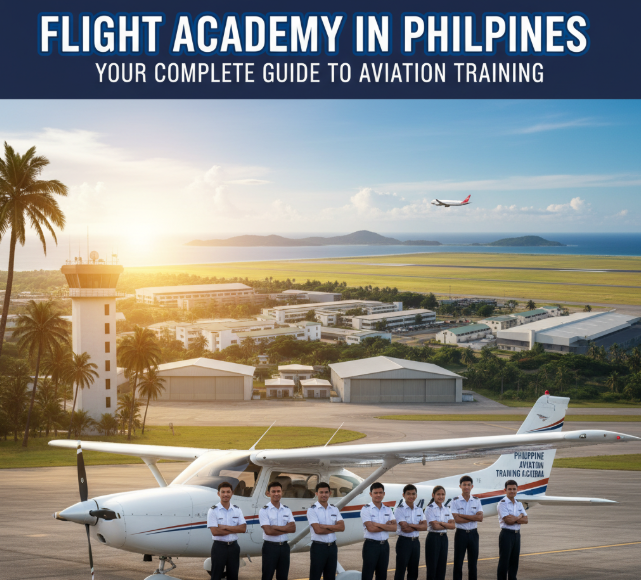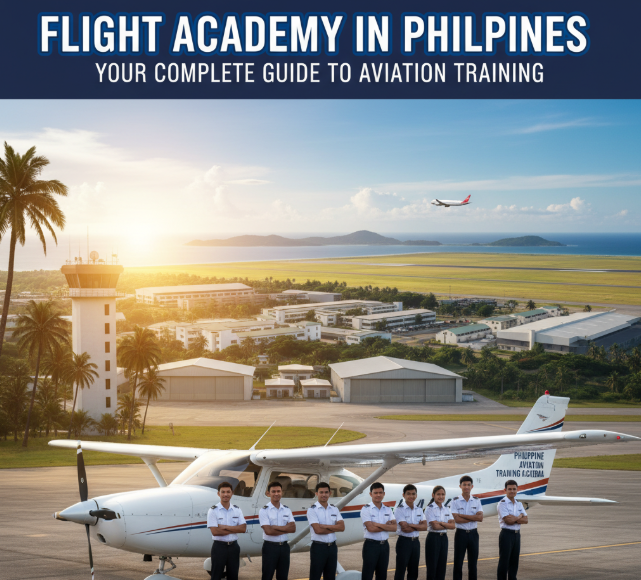
Introduction to Flight Academy in Philippines
Aviation is an exciting and dynamic field that attracts individuals with a passion for flying and a desire to pursue a career in the skies. For those aspiring to become pilots, enrolling in a Flight Academy in Philippines is one of the first steps toward realizing that dream. In this guide, we will explore the comprehensive process of flight training in the Philippines, including the history, importance, eligibility requirements, available institutes, and the future of aviation in the country. Whether you’re interested in pilot training in the Philippines, aviation careers, or becoming a part of the growing aviation industry, this blog will provide valuable insights.
What is a Flight Academy?
A Flight Academy, also known as a pilot training school, is an institution that provides comprehensive training for individuals aspiring to become professional pilots. It offers both theoretical education and practical flight experience, essential for obtaining pilot licenses. In the Philippines, flight academies offer training for various pilot certifications, including Private Pilot Licenses (PPL), Commercial Pilot Licenses (CPL), and Airline Transport Pilot Licenses (ATPL). These schools are equipped with advanced flight simulators and aircraft to train students in different aspects of flying.
The Philippines aviation institute plays a pivotal role in educating pilots and other aviation professionals, preparing them for the demands of both domestic and international aviation.
Importance of Aviation in Philippines
The Philippines has a rapidly growing aviation industry, largely due to its strategic location in Southeast Asia and its rising demand for air travel. The country’s extensive archipelago, with over 7,000 islands, makes air travel an essential mode of transport. Additionally, aviation careers in Philippines offer ample opportunities for individuals, ranging from piloting commercial airlines to working in government aviation programs and space projects.
The aviation industry contributes significantly to the nation’s economy, with major airports like Ninoy Aquino International Airport (NAIA) and Clark International Airport handling millions of passengers annually. The Philippines also serves as a hub for various international airlines, further emphasizing the importance of flight academies in training qualified pilots.
History and Development of Aviation in Philippines
Early Aviation History
Aviation in the Philippines began in the early 20th century, with the arrival of the first flight in 1910. The Philippines has since seen remarkable progress in the field, with the establishment of various airlines, airfields, and flight schools.
In 1941, the Philippine Air Force (PAF) was established, marking a significant milestone in the country’s aviation history. Over the years, the Philippines has developed a strong civil aviation sector, with several local airlines offering both domestic and international flights.
Milestones in Aviation
- Philippine Airlines (PAL): The country’s first and oldest airline, PAL, was founded in 1941. PAL is the first airline in Asia to offer transpacific flights.
- Military Aviation: The Philippines played a vital role in military aviation, especially during World War II. The Philippine Air Force has since grown and modernized, with advanced fighter jets and training programs.
- Aviation in Space Exploration: The Philippines is making strides toward space exploration, with projects like PhilSA (Philippine Space Agency) focused on satellite technology and space research.
Current Role of Flight Academy in Philippines
Flight academies in the Philippines are essential in meeting the rising demand for pilots in both the domestic and international aviation sectors. These institutions provide high-quality training programs to equip students with the skills necessary to operate aircraft safely and efficiently.
Today, flight academies in the Philippines offer various programs, from Private Pilot Licenses (PPL) to Airline Transport Pilot Licenses (ATPL). Many flight schools are affiliated with national and international airlines, ensuring that students receive top-notch training and opportunities for employment.
Role in Civil Aviation and Defense
In addition to training commercial pilots, flight academies also play a critical role in preparing individuals for defense aviation roles. The Philippine Air Force relies on qualified pilots, many of whom have undergone rigorous training in the country’s top aviation schools.
Eligibility, Training, and Skills Required
Basic Qualifications
To enroll in a flight academy in the Philippines, students must meet several basic qualifications:
- Age: Generally, applicants must be at least 17 years old to begin pilot training.
- Education: A high school diploma or equivalent is typically required, though a college degree can be advantageous.
- Health: A medical examination is required to ensure the applicant is physically fit to fly.
Technical & Soft Skills
- Navigation Skills: Pilots must be proficient in reading maps, using GPS systems, and understanding aviation charts.
- Meteorology: Knowledge of weather patterns is crucial, as it directly impacts flight safety.
- Leadership & Decision Making: Pilots need excellent leadership and decision-making skills to manage in-flight challenges and emergencies.
Institutes, Academies, and Training Centers in Philippines
Several prestigious institutions in the Philippines offer flight training programs. Below are a few renowned flight schools:
- Philippine State College of Aeronautics (PhilSCA): One of the oldest aviation schools in the country, PhilSCA offers degrees and training in various aviation fields, including pilot training.
- Flight Training Center (FTC): Known for its modern fleet of training aircraft and flight simulators, FTC offers PPL, CPL, and ATPL programs.
- Asian Institute of Aviation: Offers top-tier flight training programs that meet international aviation standards.
- Mactan Aviation: Based in Cebu, Mactan Aviation offers comprehensive pilot training, including flight theory and practical flight experience.
- Airlink International Aviation School: This school offers flight training and aviation-related courses, with a focus on safety and technical expertise.
Government Initiatives
The Philippine Civil Aviation Authority (CAAP) plays a vital role in regulating aviation activities in the country. They set the standards for pilot certification and ensure that flight academies adhere to safety protocols. Additionally, government initiatives like PhilSA contribute to the advancement of aviation in the Philippines, with a focus on technological innovation and space research.
Technology and Innovation in Aviation Training
Flight Simulators and AI Integration
The use of flight simulators is a cornerstone of modern aviation training. These high-tech simulators provide students with realistic flying experiences without the risks associated with actual flight. In addition, advancements in artificial intelligence (AI) are revolutionizing pilot training, especially in spacecraft navigation and cockpit automation. As global space programs like NASA, ISRO, and CNSA continue to innovate, Filipino pilots can gain access to cutting-edge technology in aviation training.
Digital Cockpits and Spacecraft Navigation
The integration of digital cockpits into flight training is improving pilot training efficiency. As the Philippines continues to advance its aviation programs, incorporating these technological innovations into pilot training is crucial to preparing the next generation of aviators.
Challenges Faced in Pilot Training in Philippines
While the aviation sector in the Philippines is growing, there are several challenges faced by aspiring pilots:
- Infrastructure Gaps: Some flight schools still operate with outdated training equipment, affecting the quality of education.
- Costs: The cost of pilot training can be high, making it a barrier for many students. However, scholarships and financial aid are available through various institutions.
- Regulatory Hurdles: Navigating the complex regulatory framework for pilot certification can be time-consuming.
- Brain Drain: Many pilots trained in the Philippines opt to work abroad, leaving a gap in the local aviation workforce.
Future of Flight Academy in Philippines
The future of aviation in the Philippines looks promising, with exciting developments in space tourism, private aviation, and AI-powered cockpit training. The Philippines is also poised to play a crucial role in the national and international aviation scene through projects like the Gaganyaan space program and potential collaborations with global space agencies.
Space Tourism
With the global rise of space tourism, the Philippines could become a hub for space-related aviation training. As private space programs continue to grow, aspiring pilots may find themselves training not just for commercial flights, but for missions into space.
Career Path & Opportunities
The career path for a pilot in the Philippines typically follows this structure:
- Education: Begin with a high school diploma or college degree.
- Pilot License: Enroll in a flight academy to earn a Private Pilot License (PPL), followed by a Commercial Pilot License (CPL) and eventually an Airline Transport Pilot License (ATPL).
- Advanced Training: Participate in advanced training for specific aircraft types and routes.
- Employment: Once licensed, pilots can find work with airlines, private aviation companies, or government agencies.
Salary Expectations
The salary of a Filipino pilot varies depending on experience, employer, and type of aircraft flown. On average, commercial pilots in the Philippines can expect to earn a competitive salary, with opportunities to earn more by working internationally.
Frequently Asked Questions (FAQs)
How much does pilot training cost in Philippines?
The cost of pilot training in the Philippines varies, but it can range from PHP 500,000 to PHP 2 million depending on the type of license and school chosen.
Which is the best aviation institute in Philippines?
Several top-tier flight academies in the Philippines offer excellent training programs. Some of the best include Philippine State College of Aeronautics (PhilSCA) and Airlink International Aviation School.
What qualifications are needed for pilot training in Philippines?
To begin flight training in the Philippines, applicants must have a high school diploma, pass a medical exam, and be at least 17 years old.
Is international flight training available in Philippines?
Yes, many flight academies in the Philippines offer internationally recognized training programs that allow students to pursue careers with international airlines.
What is the future of aviation in Philippines?
The future of aviation in the Philippines looks bright, with advances in space tourism, AI-driven training, and government projects aiming to strengthen the country’s aviation sector.
Conclusion
Aviation is an exciting and rewarding career choice, and the Flight Academy in Philippines offers a pathway for aspiring pilots to pursue their dreams. With a growing aviation industry, high-quality flight training institutions, and a wealth of career opportunities, the Philippines is an excellent destination for those looking to become part of the global aviation workforce. Whether you’re interested in commercial aviation or space exploration, the future of aviation in the Philippines is full of possibilities.
